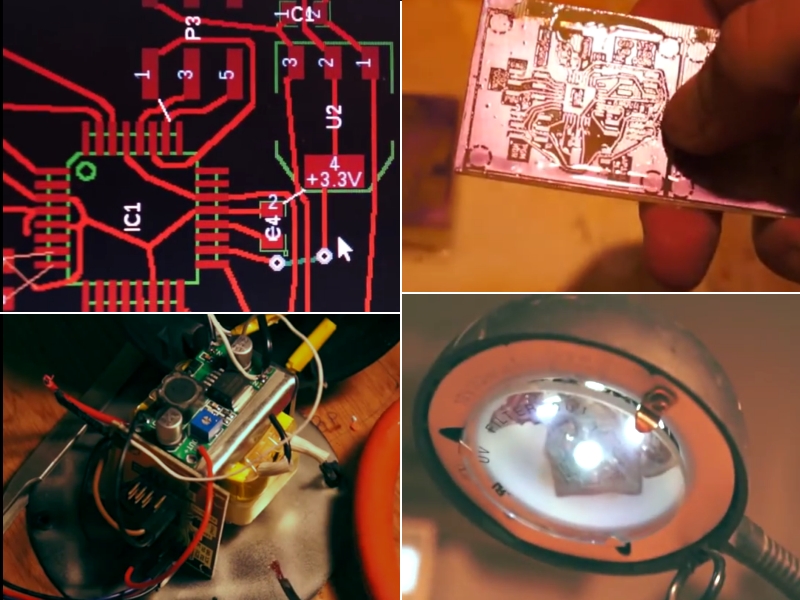“We want to get this done quick, not right.”
[CNLohr]’s favorite desk lamp broke, so he gave himself a challenge: convert the lamp to LED and control it via WiFi within 5 hours, from scratch. He video recorded and narrated the whole process and did a nice job of explaining the tricky parts and failures along the way, fast forwarding us through the slow parts.
Some bits and pieces were simple and obvious: gut the old bulb, wire some LEDs, add a few power resistors, toss in a power supply from “like a monitor or something, don’t care” for the LEDs, add in what looks like an LM2596 adjustable power supply for the logic, some kind of ATMega, that new ESP8266 (Wi07C), splice on a power cord, etc. Standard stuff.
To our readers who’s hacks tend to start with soldering irons and screwdrivers, the video shows harder parts of designing an electronics project: creating the PCB in software (he used KiCad), lithographically transferring the circuit to a PCB, bismuth solderpasting & populating the board, and writing and documenting his code on Github. Perhaps most reassuringly, he also showed the consequences of every greedy shortcut and the process of troubleshooting around them.
If you have ever tried to follow a recipe from a cooking show and noticed how easy it all seems when everything is measured and prepped beforehand – and then what a disaster it is when you try it – the same is revealed here. Overall, it is a very thorough demonstration of what it actually takes to design a project – not just perfect circuits and perfect steps to follow.
In the end he got it done in the nick of time an hour late because he cannot add. Close enough.
Thanks [gokkor] for the tip.
















Had two of these lamps break without any apparent cause, it was not the light. It turned out that the transformer had a thermal fuse inside(125 deg C maybe) which was blown due to overheating. I suspect the base ventilation to be inadequate…
I recently made simple wifi lamp with with spark core n mosfet photoresistor few resistors and diodes. Configured tasker to communicate with spark core(including UI created as scene) ..now when i’m coming home lamp turns on automatcally and maintains certain room illumination as the sun goes down. Also tasker sends lamp command to gradually turn on the light in the morning few minutes before the alarm rings …makes it much nicer way to wake up. I know spark core is overkill for the job but i have oneand itseasy to to control it. 10Wattwhwarmwhite led is now attached to old cpu sink ;]
I expect one of the early failure points to be the tape holding the LEDs in place, due to the LEDs getting warm. A TO220 mosfet would have been easier to add to the circuit.
Didn’t happen to have any that were 5V tolerant. They were all 10V Vgs :-/
Also, it’s been a couple months, the tape’s still going strong (along with the rest of the light!)
Just from the top of my head:
I would use the ESP8266 alone on ESP-01 form factor, using GPIO0 for relay control and GPIO2 for sensing on/off state. I would combine it with the manual switch to make sure I can turn the lamp on and off without wifi.
Using simple Lua script (nodeMCU) it would be probably feasible using test PCB within minutes ;)
Unfortunately, I do not have such lamp – I’d try that ;)
I wouldn’t use Lua, I’d just write my own from C (see other video where I show how) and it would be muuuuch simpler, but I did this project before these options were available.
Well done, why not head on over to http://www.esp8266.com and start a nice thread there for all of us to get inspired by! Would love to see more posts like this in the community!
WiFi, now as accessible as light
see the reinvention of lightBulb in http://www.glowry.net/